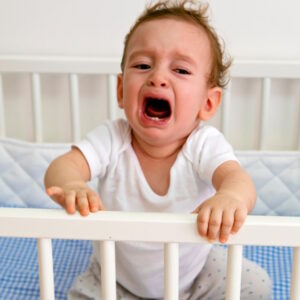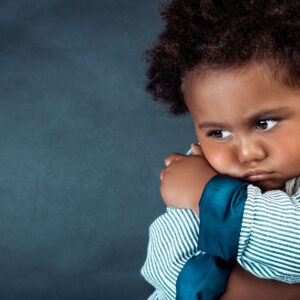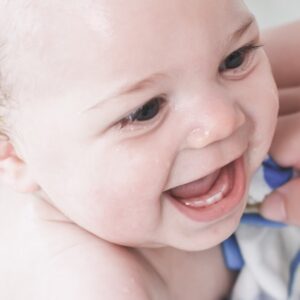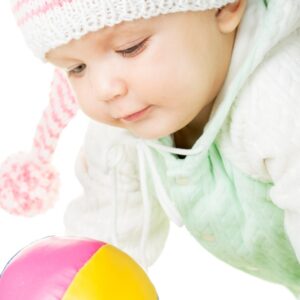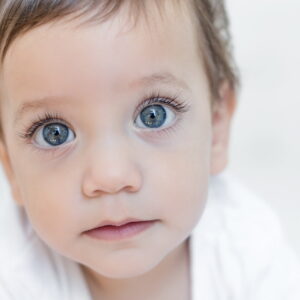Does your baby or toddler cry when left alone? Most likely, this is due to separation anxiety, which is actually one of our children’s important developmental milestones. But even if it is normal, this phase can be pretty tough for us parents, especially if we have more than one child to attend to. But there are ways to deal with the situation and help your baby overcome their separation anxiety.
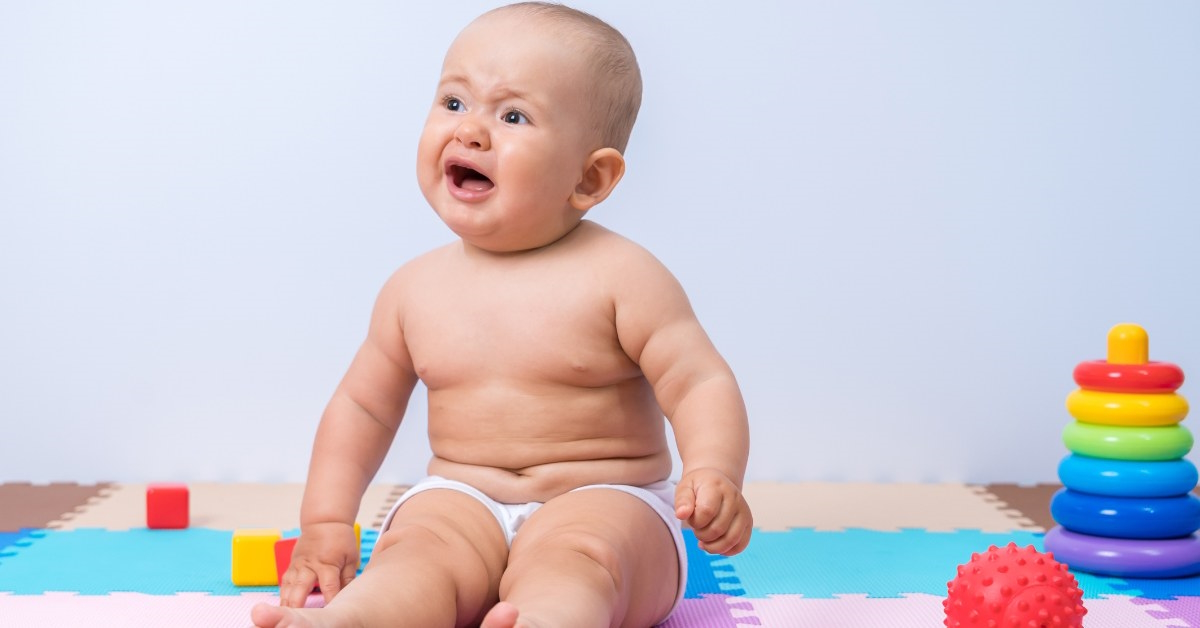
A baby or toddler who cries at the top of their lungs if not carried by their primary caregiver, can’t sleep at all alone, or seems to be very scared in new situations can be quite exhausting. But understanding what is going on and how we can help our children overcome their anxiety helps. It is also important to know when the child’s symptoms indicate an anxiety level that should be addressed by a pediatrician or mental health expert (the latter is mainly for older children).
Babies and young children go through a period of separation anxiety as part of their expected development. Older children can also experience separation anxiety. However, there may be situations where some children prefer the security of their parents or home environment to the extent that it limits their interactions with others. In severe cases, it can prevent them from attending school or participating in peer activities and social gatherings. These can be signs of separation anxiety disorder. It is, therefore, important for families to distinguish normal hesitation from severe separation anxiety to prevent future difficulties.
Here, we go through how separation anxiety in children presents at different ages and what would indicate a problem to address.
In this Article:
What Is Separation Anxiety?
Separation anxiety is defined as an infant or child becoming upset or distressed when they must physically separate from the parent or primary caregiver. It can occur both within the home or when the child is at another location.
Children may also exhibit separation anxiety with grandparents, nannies, or other adults who routinely care for them.
Throughout the first few years of life, infants and children develop strong emotional bonds with their parents and closest caregivers. Forming such bonds is vital for cognitive and social development. It fosters feelings of safety and self-confidence to interact with the world around them.
Normal separation anxiety improves over time as the infant or child becomes increasingly comfortable when the parent or caregiver is absent.
In contrast, separation anxiety disorder is a more severe form that prevents the child from engaging appropriately in everyday activities.
How Does Separation Anxiety Look At Different Stages of A Child’s Life?
Infants
The onset of separation anxiety
Separation anxiety typically starts at six to seven months. At this age, most infants have developed a strong emotional bond with their parents. After months of feedings, diaper changes, and bedtime soothing, babies learn to associate feelings of security with their parents. They also begin to understand the concept of “object permanence,” meaning an awareness of when the parent is not with them. Because infants don’t yet understand time or that “out of sight” doesn’t mean “gone forever,” they become upset.
Signs of separation anxiety in babies
For example, parents may hear crying after leaving a room while their baby is in a crib or playpen. Even if the parent’s voice is still audible, the baby cries because the parent is not in view. In particular, this can make sleep training difficult if the baby cries after being put to bed and the parent exits the room. Versions of the “cry-it-out method” to get the baby to fall asleep alone are not recommended during this time, as it may actually make the baby’s sleep worse rather than better. Introducing a calm and cuddly bedtime routine where you slowly remove yourself physically from your child but remain in sight may work better.
Drop-off time can be challenging when infants attend daycare or are cared for by someone else while the parent works. The baby may cry and cling to the parent, not wanting to be left.
Although separation anxiety can be difficult, at this age, it is a normal stage of development and expected.
Toddlers
How long does normal separation anxiety last?
The typical separation anxiety that begins during infancy can persist until around three years of age.
Toddler behavior and separation anxiety triggers
Toddlers may also start having temper tantrums, making parent tasks even more challenging. Drop off at a babysitter’s or grandparent’s home may result in a full-blown screaming, fall-on-the-floor episode. Some toddlers, anticipating this separation, may resist getting dressed or into their car seats. Parents may also witness separation anxiety during doctor visits. The only successful way to do the exam is with the child on the parent’s lap.
Toddlers also become more aware of changes in their lives or daily routines. A child previously separated from the parent without complaint may become more hesitant after moving to a new home, starting potty training, or attending daycare for the first time.
The arrival of a new baby can also trigger separation anxiety. For example, the toddler may resist separating from mom when it is time to feed the baby. It can take time to adjust to sharing “parent time.” They may also turn against the baby and “hate” their new sibling, who, in their mind, is stealing the parents.
Ages Four and Up
By the time a child is four years old (and may begin, e.g., a structured pre-school or school program), they should have minimal to no separation anxiety.
The sense of trust and socio-emotional bonds that formed during the first three years of life should enable them to feel secure when separated from their parent.
Even children who are inherently shy should still be able to participate in school, meet new people, and socialize with peers. When this is not the case, the child may have separation anxiety disorder or another condition that prevents age-appropriate behavior.
What Is Separation Anxiety Disorder?
When a child experiences severe distress at the thought of being away from a parent or caregiver, it is called separation anxiety disorder. In such cases, this anxiety significantly impacts the child’s ability to function in life. Because of this aspect, it is classified as a specific type of anxiety disorder.
Characteristics include:
- Tantrums or becoming very upset when the parent or caregiver leaves
- Refusing to leave home to attend school, social events, and extracurricular activities
- Worrying that something bad will happen to the parent while they are apart
- Unable or unwilling to sleep without the parent nearby
- Frequent nightmares about something terrible happening to the parent
- Worry about a home invasion or kidnapping that would result in separation
- Experiencing headaches or stomach aches prior to separating from the parent or caregiver
Children with three or more of these symptoms for at least four weeks are diagnosed with separation anxiety disorder. The average age of onset is seven years old. It is more common among children with a family history of other types of anxiety disorders. The sudden loss of a family member or parent can trigger separation anxiety in a child with no previous signs or symptoms. Stressful home or life situations that create challenges in infant-parent bonding can contribute to the development of this disorder.
Children with separation anxiety disorder may become so distressed that they experience panic attacks or exhibit obsessive-compulsive behaviors.
Medical Conditions With Symptoms That Mimic Separation Anxiety
Childhood Anxiety
Children and adolescents can develop social phobia or other types of anxiety disorders similar to adults. These conditions often make it difficult for kids to do well in school, develop friendships, and engage socially. For example, the child may not feel comfortable vocally participating in class. An extreme form of this is known as selective mutism.
These children easily have conversations with family members at home or with a few trusted friends but refuse to speak in other settings.
In other cases, the child may complain of headaches or stomach aches only on school days, sometimes resulting in school absences or leaving early. Bullying at school or elsewhere may exacerbate symptoms.
These childhood anxiety types differ from separation anxiety disorder because they are unassociated with separating from a parent or caregiver.
Autism Spectrum Disorder
Over 40 percent of children with autism experience some form of anxiety. This can include separation anxiety. Initially, limited eye contact or responses to social cues may affect parent-child bonding. However, over time, most children with autism associate comfort and routine with their parents, siblings, and regular caregivers. As a result, they resist deviating from this routine, making interactions with peers, teachers, healthcare professionals, and other more unfamiliar people more difficult.
Such behavior can mimic separation anxiety because the child prefers to remain near the parent or trusted loved one. However, other aspects of autism, such as speech/language difficulties, avoiding eye contact, and repetitive behaviors, distinguish it from separation anxiety.
What Can Parents Do to Help Infants and Children with Separation Anxiety?
Infants
As previously stated, separation anxiety is normal for older infants. Parents need to have patience and realize that it is usually temporary. Here are some strategies to help babies adjust and parents to feel less stressed:
Practice separation while at home. Play peekaboo games with a big smile. It is also not necessary for infants to always be in the same room as their parents. Putting the baby in a separate but safe space, such as a playpen, teaches solitary play skills and fosters comfort with separation. This can be first done for very short periods of time. If, initially, the baby cries, start by placing the playpen in a separate room (or even in the same room) where the baby can still see you. Later, the playpen can be moved out of view. Physical separation is particularly important while preparing meals. Holding a baby or wearing a carrier while cooking can result in injuries.
Create a fun and happy goodbye ritual and make the “goodbyes” quick. When sending a baby to the daycare center or a new sitter, prolonged goodbyes can increase the crying and distress for you and the baby. In most cases, once the parent leaves, the baby becomes calm after a few minutes. It may take a few weeks to months for drop-offs to become less tearful, and most babies tend to adjust.
Avoid new environments and situations, including new childcare, after separation anxiety begins. Transitioning to daycare or a new babysitter may be easier before or after the separation anxiety phase. In addition, stranger anxiety also begins between seven to nine months old. The combination of these two developmentally normal behaviors can make the transition to childcare more challenging.
Toddlers
Give reassurances and keep promises. Providing lots of positive encouragement can gradually help your toddler to feel comfortable being away from you. Having an older sibling or similar-aged friend present can be helpful. Letting your child know that you will be coming back later helps reinforce trust and reduce the child’s fear and anxiety.
Maintain a routine. Toddlers thrive when they know what to expect from their parents and home environment. A “going out” routine can help children mentally prepare for what will occur after they leave home. Including tasks such as getting dressed, eating a meal, and getting into the car seat into the routine can improve compliance. Discussing what will happen at the destination can provide the toddler extra reassurance.
Take care of any needs prior to the separation. A toddler who has become hungry or overtired is likelier to cling to the parent. If your child is ill, they may need additional comfort from you. Knowing when it is appropriate to separate is key and can prevent the worsening of separation anxiety.
Just like with babies, toddlers may wake up at night and not be able to go back to sleep due to separation anxiety. A peaceful bedtime routine and a lovey (comfort object) may help, but it is important to understand as a parent that this is a normal stage of emotional development and that the night wakings will pass. Many young children sleep part of the night in their parents’ bed during these years, as they wake up at night and are not able to go back to sleep on their own.
School-aged Children
Some of the same strategies that are helpful for infant and toddler separation anxiety can also work well for school-aged children. Maintaining a routine and being clear on when you will return can help foster trust and self-confidence. Encouraging engagement with peers and in sports or other activities your child enjoys can also build self-esteem when the parent is not around.
However, children with separation anxiety disorder may need additional help from medical and mental health professionals. Parents should speak with their pediatrician or family doctor about any concerns. A doctor can help distinguish separation anxiety from other medical or psychological conditions.
In some cases, a referral to a family therapist is recommended. This can teach parents and caregivers how to help and allow the child to express feelings in an emotionally safe place.
Cognitive behavioral therapy may be offered as well. It helps to reduce worrisome thoughts and better manage feelings of anxiety.
A psychiatric evaluation and prescription medication may be considered for severe cases of separation anxiety that prevent school attendance or cause frequent anxiety attacks.
Takeaway
While exhausting for parents, the good news is that separation anxiety is a normal part of development in babies and toddlers. Your baby’s tears and fears are real, and their reaction is not due to being spoilt. During this time, the focus from parents should be to help the child become more comfortable when not having the caregiver near. This includes responding to their needs and slowly practicing separation in different ways, for example, at home.
Remind yourself that separation anxiety will only last for a relatively short period of time. Do not let your own frustration over the situation spill over to your child since this will only make the situation worse.
For older children, severe issues with separation from their parents may be symptoms of separation anxiety disorder or other medical conditions, such as childhood anxiety or autism spectrum disorder. If your child hesitates or refuses to participate in normal activities for their age due to separation anxiety, do not postpone contact with your child’s healthcare provider.
Read Next
- My Baby Is Afraid Of Strangers?! Guide to Stranger Anxiety
- My 2-Year-Old Is Clingy After Separation And Doesn’t Like My Boyfriend
- Fussy 8-Month-Old Baby Just Cries: 6 Efficient Tips to Try!
- 10-Month-Old Wants To Be Carried All The Time! What to Do?
Research References
- Nemours Kids Health: Separation Anxiety
- Feriante J, Torrico TJ, Bernstein B. Separation Anxiety Disorder. [Updated 2023 Feb 26]. In: StatPearls [Internet]. Treasure Island (FL): StatPearls Publishing; 2023 Jan-.
- American Academy of Pediatrics, HealthyChildren.org: My daughter is extremely shy and anxious around strangers. How can I help her?
- Patel AK, Bryant B. Separation Anxiety Disorder. JAMA. 2021;326(18):1880. doi:10.1001/jama.2021.17269
- Dhote VS, Dharmadhikari PM, Bahadure RN, Thosar NR, Dhote AV. Separation Anxiety-An Unseen Cause for Development of Abnormal Oral and Paraoral Habits and Malocclusion: A Review of Literature and Report of Two Cases. Int J Clin Pediatr Dent. 2021;14(Suppl 2):S199-S205. doi: 10.5005/jp-journals-10005-2091. PMID: 35645476; PMCID: PMC9108798.
- Muris P, Ollendick TH. Current Challenges in the Diagnosis and Management of Selective Mutism in Children. Psychol Res Behav Manag. 2021 Feb 16;14:159-167. doi: 10.2147/PRBM.S274538. PMID: 33623447; PMCID: PMC7896755.
- Perihan, C., Bicer, A. & Bocanegra, J. Assessment and Treatment of Anxiety in Children with Autism Spectrum Disorder in School Settings: A Systematic Review and Meta-Analysis. School Mental Health 14, 153–164 (2022). https://doi.org/10.1007/s12310-021-09461-7

Paula Dennholt founded Easy Baby Life in 2006 and has been a passionate parenting and pregnancy writer since then. Her parenting approach and writing are based on studies in cognitive-behavioral models and therapy for children and her experience as a mother and stepmother. Life as a parent has convinced her of how crucial it is to put relationships before rules. She strongly believes in positive parenting and a science-based approach.
Paula cooperates with a team of pediatricians who assist in reviewing and writing articles.


